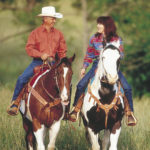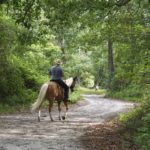
Eventing is one of the three disciplines that will be featured at the 2012 Olympic Games. Known as the triathlon of equestrian sports, eventing is made up of three phases: dressage, cross-country and jumping, with one phase held on each day of competition.
The first competition that resembled eventing was held in 1902, and according to the United States Eventing Association, the object of the ?event? was to test cavalry officers? chargers on their fitness and suitability.
Dressage at the time was designed to demonstrate the horse’s ability to perform on the parade ground. Cross-Country tested the stamina and courage of the mount and Jumping showed the horse’s continued fitness and agility after the other phases of competition.
Eventing as an Olympic sport is similar, but has evolved through several different formats through the years, including one format that eliminated dressage all together and longer formats where cross-country had several phases within. It wasn?t until 2004 and 2005 that the current eventing format was used in the Olympics and standardized for all international competitions.
What will Eventing be like at the Games?
Eventing at the Games will be the highest level of competition, and will consist of dressage, cross-country and jumping. Each competitor will complete one phase per day, and they will be riding the same horse during the entire competition.
Dressage for the 2012 Games will be spread over two days because of the number of competitors. The test, however, will be similar to a regular dressage test. Riders will be required to complete a series of movements in an arena surrounded by letters. Judges will be positioned around the arena and will score each rider based upon the accuracy and the appearance of their test.
Cross-Country is the second phase of the competition and arguably one of the most thrilling competitions to watch. Riders are required to complete a course of natural obstacles over varying terrain. This includes solid jumps that look like trees or natural obstacles, as well as water jumps, ditches and more. At the 2012 Games, cross-country will take place on a course with about 45 jumps in Greenich Park.
The final day of the competition is jumping. Riders are back in the outdoor stadium completing a course of colorful jumps, and trying to prove that their horses have retained their fitness and obedience after the previous two phases. The object is to refrain from knocking down the rails of the jumps and complete the course within the time allowed.
How is all of this scored?
After each rider completes the dressage test, the scores they receive from the judges will be converted into a penalty score. Penalties from the rest of the phases will be added to this score throughout the competition.
On the cross-country course, riders can receive penalties several ways. If a rider has refusal, run out or circle at a fence, they will receive a 20 point penalty for the first occurrence. Add 40 points for the second occurrence at the same fence and they will be eliminated after the third occurrence. Riders can also be eliminated for going off course or missing an obstacle. In addition, riders who exceed the optimum time will receive a .4 point penalty per second.
In jumping, penalties are issued when rails are knocked down. Each jump on the course will have a number of rails that create its height. If a rider knocks down a rail he will receive four penalty points. He will also receive four penalty points for a refusal at a jump. Two refusals will result in elimination. Each rider is timed during his round, and if he exceeds the time allowed he will receive one penalty point per second.
Riders will complete the jumping course in reverse order of placing. Once everyone has finished, the rider with the lowest cumulative score from all three competitions will take the gold. If two riders have the same score, the one with the best cross-country score will win. If there is still a tie, the rider with the best jumping score will win.
For the team competition, the three best scores will be used and the team with the lowest combined score will win. If there is a tie (which is rare) the team with the best combined individual placings will win.
Is that it?
Nope. Similar to endurance, horses in the eventing competition must pass several veterinary inspections. The inspections are not timed; however horses must pass them to be able to continue the competition.
The first horse inspection takes place before the competition begins. Horses will be inspected by a veterinarian while standing and at a jog to prove that they are sound and fit to compete.
The second horse inspection takes place on the morning of the jumping competition. It is conducted by the same committee as the first inspection. This inspection insures that horses are still sound and fit to compete after the strenuous cross-country phase the day before.
If any competitor fails to pass a veterinary inspection he will be eliminated from the competition. Veterinarians will also be examining horses immediately after completion of the cross-country course and as needed during the entire competition.
What does the competition look like?
A unique aspect of eventing is that spectators get to see something different every day of the competition. This includes the riders? appearance and equipment. On the day of dressage, spectators will see riders in formal attire; usually a top hat, tailcoat and white or tan pants. Horses will be immaculate, with braided manes and dressage tack.
For the cross-country, riders are required to wear a safety vest, helmet and an arm band with medical information. Attire is more casual and riders get to dress in the colors of their choice. Normally riders will wear lightweight clothing that coordinates with their horses’ tack. Horses are still clean and tidy for cross-country, but they are decked out in safety equipment, which can include boots on their lower legs, boots over their hooves and sometimes ?eventing grease? slathered on their legs. A jumping saddle is used for cross-country and most riders will be carrying a whip.
On the third day riders are more formal again for the jumping competition. They’ll be wearing coats and nice pants, but helmets instead of top hats. Horses will look fancy again with braided manes and gleaming coats. This day wraps up the competition, and spectators will have seen the versatility of both horse and rider athletically and visually throughout the three phases.
Fan Etiquette
Because there are three different competitions in eventing it is important to know the appropriate way ?spectate? during each. All phases require intense concentration on the rider?s part, however cheering is acceptable at different times during each phase.
During the dressage test, it is best for spectators to remain quiet. Once the rider has halted his or her horse at the completion of the test cheering is acceptable. On cross-country, cheering is acceptable after horses pass in the open as long as it is not disruptive. At jumps, spectators should remain quiet until the horse and rider have completed the jump or jumps in the area, then cheering is encouraged.
For jumping, spectators should wait until the end of the rider?s round to cheer.
Both the dressage and jumping phases of eventing will take place in the outdoor stadium. Because the cross-country course runs throughout the park, spectators are able to wander around to different jumps or obstacles and get an up-close view of the action. Spectators should make sure not to walk onto the cross-country course at an y point unless they are passing through a crossing point manned by competition officials.





